#ubangi club
Text

Gladys Bentley at the Ubangi Club in Harlem, early 1930s.
Gladys Bentley (1907-1960) joined the Harlem Renaissance jazz scene at age 16 and became an instant sensation and gender identity pioneer. She performed piano and vocals at the most popular gay bars, wearing men’s clothing, and openly flirted with women in the audience. She headlined in the early 1930s at Harlem's Ubangi Club, where she was backed up by a chorus line of drag queens. She dressed in men's clothes (including her signature: tuxedo and top hat), played piano, and sang her own raunchy lyrics to popular tunes of the day in a deep, growling voice.
Photo: Sterling Paige via Artblart
#New York#NYC#vintage New York#1930s#Sterling Paige#Gladys Bentley#lesbians#LGBTQ+#queer#Ubangi Club#Harlem#vintage Harlem#old NY
1K notes
·
View notes
Text
Sometimes, the line between "drag artist" and "performer who is queer" becomes incredibly blurry and hard to define.
One of the most famous queer artists of the Harlem renaissance was Gladys Bentley, who was openly a lesbian and who wore men's clothing as a part of her stage persona.
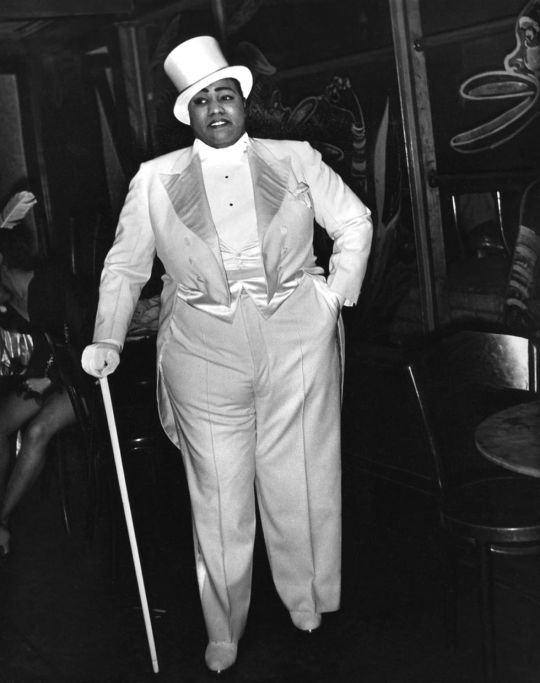
Bentley sometimes used the term "male impersonator" as a way of being able to wear masculine attire on stage, but she was never fully pretending to be male. She was always being herself.
A virtuouso piano player, she was called "America's Greatest Sepia Piano Player" and the "Brown Bomber of Sophisticated Songs" She headlined at places like Cotton Club and the Ubangi Club, and always drew in massive crowds.
youtube
Described by Langston Hughes, "For two or three amazing years, Miss Bentley sat, and played piano all night long … with scarcely a break between the notes, sliding from one song to another, with a powerful and continuous underbeat of jungle rhythm. Miss Bentley was an amazing exhibition of musical energy – a large, dark, masculine lady, whose feet pounded the floor while her fingers pounded the keyboard – a perfect piece of African sculpture, animated by her own rhythm."
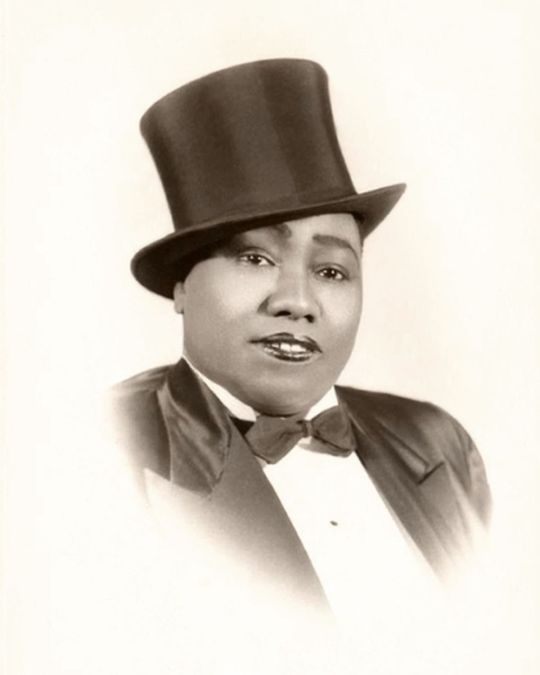
Gladys Bentley was far from being the only queer woman blues singer of the day. Lucille Bogan, Bessie Smith and Ma Rainey also had sexual relationships with women, and sang songs about same-sex desire and "bulldaggers."
youtube
Even still, Bentley stood out for her unabashed queerness. When performing at the Ubangi Club, she had a chorus line of drag queens performing behind her.
As time wore on and America became more conservative, Bentley's career struggled. In the 1950s, she renounced her old ways and claimed she had been "cured" of lesbianism and "become a woman again" through a regimen of estrogen shots. It was the only way she was able to maintain a career through the McCarthy era.
youtube
#lesbian#lesbian history#drag#history of drag#gay#queer#Youtube#lgbt#gay history#queer history#lgbt history
843 notes
·
View notes
Text
my dad and i where talking about how one of his openly gay friends didn't like the progress LGBTQIA+ flag because it included POC. He said 'why should there be a distinction for a community thats based for people who are queer in gender and sexuality?'. unfortunately i didnt get to talk to the guy, but my dad was trying to defend his friends position. since a lot of white gays dont know how much POC have helped our community so im gonna give a couple names that have helped the LGBTQ+ community.
Gladys Bentley (1907-1960)
Bentley was a gender-bending performer during the Harlem Renaissance. Donning a top hat and tuxedo, Bentley would sing the blues in Harlem establishments like the Clam House and the Ubangi Club. According to a belated obituary published in 2019, The New York Times said Bentley, who died in 1960 at the age of 52, was "Harlem's most famous lesbian" in the 1930s and "among the best-known Black entertainers in the United States."
Bayard Rustin (1912-1987)
Rustin was an LGBTQ and civil rights activist best known for being a key adviser to Reverend Martin Luther King Jr. He organized the 1963 March on Washington and was posthumously awarded the Presidential Medal of Freedom, the nation’s highest civilian honor, in 2013 for his activism. In 2020, Gov. Gavin Newsom pardoned Rustin for his arrest in 1953 when he was found having sex with two men in a parked car in Pasadena. Rustin served 50 days in Los Angeles County jail and had to register as a sex offender. In pardoning Rustin, Newsom noted how LGBTQ people were unjustly punished for their sexuality by U.S. law enforcement at the time Rustin's arrest.
Stormé DeLarverie (1920-2014)
A biracial, butch lesbian, DeLarverie was born in New Orleans, Louisiana, and was always a performer. As a teenager, she joined the Ringling Brothers Circus where she rode jumping horses. Then from 1955 to 1969, DeLarverie toured the Black theater circuit as the MC — and only drag king — of the Jewel Box Revue, the first racially integrated drag revue in North America. She worked as a bouncer for several lesbian bars in New York City in the ‘80s and ‘90s, and held a number of leadership positions in the Stonewall Veterans Association. DeLarverie also served the community as a volunteer street patrol worker, and as a result, was called the "guardian of lesbians in the Village." Beyond her LGBTQ activism, DeLarverie also organized and performed at fundraisers for women who suffered from domestic violence and their children.
Marsha P. Johnson (1945-1992)
Marsha P. Johnson — who would cheekily tell people the "P" stood for "pay it no mind" — was an outspoken transgender rights activist and is reported to be one of the central figures of the historic Stonewall uprising of 1969. Along with fellow trans activist Sylvia Rivera, Johnson helped form Street Transgender Action Revolutionaries (STAR), a radical political organization that provided housing and other forms of support to homeless queer youth and sex workers in Manhattan. She also performed with the drag performance troupe Hot Peaches from 1972 through the ‘90s and was an AIDS activist with AIDS Coalition to Unleash Power (ACT UP).
these are just 4 of the 16 from https://www.nbcnews.com/news/amp/ncna1130856 . there is rich history that POC's history and LGBTQ's intertwine. we as white queer people need to do our research on our own community. its important to understand why intersectionality is so important. unfortunately white gays are the worst offenders of this and need to be informed of their own history.
#lgbtq#pride#lgbtqiia+#pride month#trans#transgender#nonbinary#trans positivity#trans pride#lgbtqplus#intersectional activism#intersectionality#interstitial#gay#lesbians#bisexaul#lgbt#queer#pan
107 notes
·
View notes
Text
h/t Have a Gay Day….
Gladys' performances were overtly gay. She loved to show off her glamorous girlfriends and she openly flirted with women in the audience. Her cabaret show at the Ubangi Club even featured a cast of drag queens. She never hid the fact that she was lesbian and was happy to tell the press that she had married a white woman. But with the end of the Harlem Renaissance and the beginning of the Great Depression, tolerance for LGBTQ people began to wane. Gladys once again packed her bags; this time her destination was California. There, she continued to play in gay clubs and make records but she never achieved the level of success she had enjoyed in New York.
In the 1940s and 50s, McCarthyism threatened the livelihoods of LGBTQ people. The so-called "lavender scare" saw LGBTQ people as a threat to American values as well as to national security because it was thought they were easily manipulated. So, LGBTQ people were often blacklisted or even arrested. Afraid of prosecution, Gladys hung up her top hat and started to wear dresses. She published a desperate article in Ebony magazine titled "I am Woman Again," in which she claimed to have cured her homosexuality by undergoing female hormone treatments. She went so far as to marry a man, only to later have him deny the marriage ever took place. Sadly, Gladys died of pneumonia before the start of the gay rights movement. Although she had once been so proud of her queerness, Gladys was forced to spend the end of her life in the closet.
Celebrate Gladys Bentley.
h/t Seliah Deleon
[Image Description: A sepia portrait of Gladys with a top hat, suit, bowtie, groomed brows, and lipstick on. End ID].
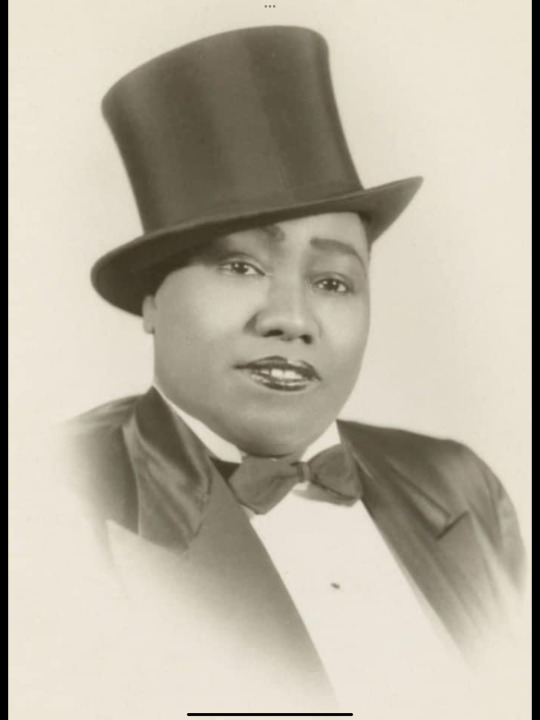
2 notes
·
View notes
Photo
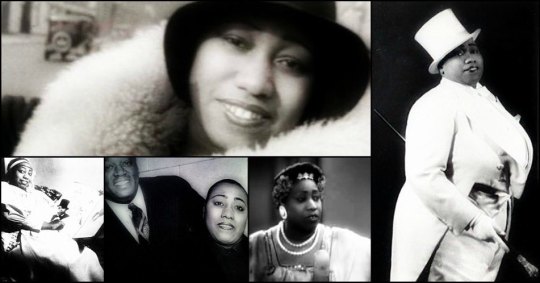
Gladys Alberta Bentley (August 12, 1907 – January 18, 1960) was a blues singer, pianist, and entertainer during the Harlem Renaissance. Her career skyrocketed when she appeared at Harry Hansberry's Clam House in New York, as an African American, lesbian, cross-dressing performer. She headlined at Harlem's Ubangi Club, where she was backed up by a chorus line of drag queens. She dressed in men's clothes, played piano, and sang her raunchy lyrics to popular tunes of the day in a deep, growling voice while flirting with women in the audience. On the decline of the Harlem speakeasies with the repeal of Prohibition, she relocated to Southern California, where she was billed as "America's Greatest Sepia Piano Player" and the "Brown Bomber of Sophisticated Songs". She was harassed for wearing men's clothing. She tried to continue her musical career but did not achieve as much success as she had had in the past. She was openly lesbian early in her career, but during the McCarthy Era, she started wearing dresses and married, claiming to have been "cured" by taking female hormones. #africanhistory365 #africanexcellence https://www.instagram.com/p/ChJoZ2RucsHDSnM1B1Nt_ivTTUchD_CGH2guHg0/?igshid=NGJjMDIxMWI=
0 notes
Text
Sophie Tucker and Gladys Bentley

Sophie Tucker and Gladys Bentley
Against her family's wishes, Sophie Tucker (1884-1966) went into vaudeville and became an international star. She sang Blues and Jazz but is best known for her comedy songs often with risqué lyrics earning her the nickname the “Last of the Red Hot Mamas”.
Because she was considered too big and too ugly to perform as a white woman, she had to start out in blackface even though she hated it. While performing in Boston, the costume trunks were lost and she was finally able to go on stage without blackface. She shocked the audience by declaring “You-all can see I’m a white girl. Well, I’ll tell you something more: I’m not Southern. I’m a Jewish girl and I just learned this Southern accent doing a blackface act for two years. And now, Mr. Leader, please play my song.” The audience adored her wit, charm, talent, and body-positive attitude. She never had to wear blackface again.
Her two most famous songs are her signature song, “Some of These Days” (written in 1910 by Black composer Shelton Brooks) and “My Yiddishe Momme” which honored her Jewish heritage and is still sung in both Yiddish and English. In 1932, Sophie was met with antisemitism at a concert in France when she sang it, and in Germany, her records were smashed.
Tucker was deeply committed to helping others. She contributed to the Jewish Theatrical Guild, the Catholic Actors Guild, the Negro Actors Guild, and formed the Sophie Tucker Foundation. She donated to synagogues and hospitals. While on the road, she would help prostitutes by giving them money to stash away from their pimps. She and her band even did a performance at a house of prostitution who had taken the night off in her honor. She saw the women as people just trying to do their best in a difficult world and never judged them.
Sophie Tucker was one of the most popular and beloved performers of the 20th Century. She was a dear friend of Dr. Margaret “Mom” Chung (WCW 68). Comedian and actor Bette Midler’s character, “Soph”, is a direct reference to Sophie Tucker.
Gladys Bentley (1907-1960) was another beloved performer of the 20th Century. She sometimes used the stage name Bobbie Minton. Similar to Sophie Tucker, she did not fit the standard beauty norms. Outspoken, large, lesbian, and Black, she wore a trademark white tuxedo on stage.She was a fierce piano player and powerful singer who pushed the limits with racy lyrics and bawdy manner.
Even as a child, she felt more comfortable dressing in men’s clothing. Despite struggling financially, her parents took her to many doctors to cure her. At sixteen she ran away to New York to become a performer. Boldly flaunting her bulldagger (butch) style, she became a super star of the Harlem Renaissance and performed at all the best clubs such as the Clam House, the Cotton Club, and the Apollo. Bentley headlined at the Ubangi Club with drag queens as her chorus. As a Black lesbian woman in the 1920s, she owned a Park Avenue apartment with servants and famously “married” a white woman.
Times became tough for her during the depression. Most nightclub work dried up. She moved to Los Angeles and was often harassed for wearing men’s clothing but was able to keep working enough to survive by performing at the underground gay clubs there.
Sadly, the social climate of the 50s was too much for her to bear. She had to deny who she was. In 1952, she published an essay called “I Am A Woman Again” in “Ebony” magazine. She publicly declared that she had been “cured” of lesbianism and was happily married to a man. She later divorced him and was preparing to become an ordained minister for The Temple of Love in Christ, Inc., but she died of the flu before she could achieve that goal. She was 52 years old.
Bonus Links:
Sophie Tucker singing “My Yiddishe Momma”
https://youtu.be/triCX77tl8s
Discography for Sophie Tucker
https://adp.library.ucsb.edu/index.php/mastertalent/detail/105584/Tucker_Sophie
Gladys Bentley appeared twice on Grocho Marx’s “You Bet Your Life” This is the only record of her television appearance.
https://www.youtube.com/watch?v=j-LTJNasTMc
Discography of Gladys Bentley (Most of her repertoire was not recorded.)
https://adp.library.ucsb.edu/index.php/mastertalent/detail/107258/Bentley_Gladys
Sources:
https://jwa.org/encyclopedia/article/tucker-sophie
https://legacyprojectchicago.org/person/gladys-bentley
https://www.blackpast.org/african-american-history/bentley-gladys-1907-1960/
#suffragettecity100#sophie tucker#yiddish#yiddisha momma#jazz#blues singer#women in showbusiness#vaudeville#red hot mama#some of these days#jewish girl#gladys Bentley#bobbie minton#lesbian#black lesbian#black woman#black history#harlem renaissance#clam house#ubangi club#drag queen#bulldagger#transgender#LGBTQ#gender bender#blackface#jazz singer#african american history#blacklivesmatter#women's history
4 notes
·
View notes
Photo
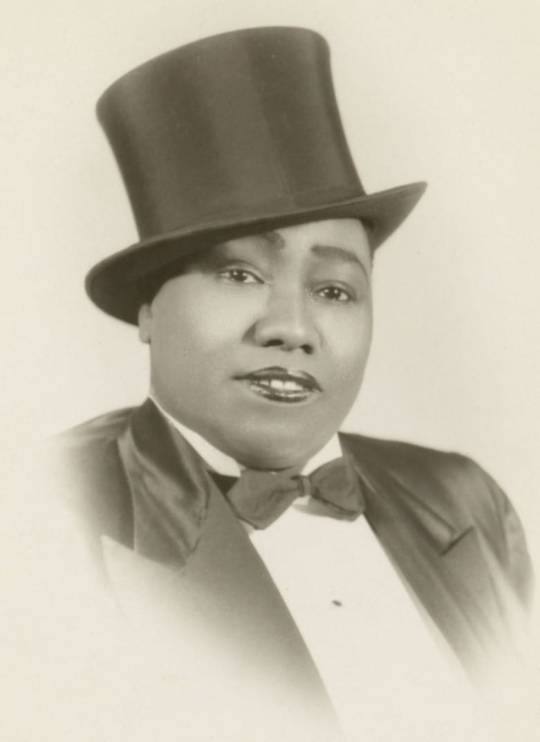
🏳️🌈 Gladys Bentley (1907 - 1960) was bullied by her classmates and ostracized by her family for being an overweight tomboy. At 16, she packed up to leave her hometown of Philadelphia and headed to Harlem. When she first arrived, she made her money singing and playing the piano at private parties. But when she heard that the local gay bar was looking for a male pianist, Gladys knew what she had to do. She donned a tuxedo and top hat and took the gig for $35 a week. Her talent for mixing popular tunes with her own raunchy lyrics soon attracted record crowds and once wealthy white people started showing up, management tripled her pay. Eventually, she was successful enough to live in a Park Avenue penthouse with, in her words, "servants and a nice car."
Gladys' performances were overtly gay. She loved to show off her glamorous girlfriends and she openly flirted with women in the audience. Her cabaret show at the Ubangi Club even featured a cast of drag queens. She never hid the fact that she was lesbian and was happy to tell the press that she had married a white woman. But with the end of the Harlem Renaissance and the beginning of the Great Depression, tolerance for LGBTQ people began to wane. Gladys once again packed her bags; this time her destination was California. There, she continued to play in gay clubs and make records but she never achieved the level of success she had enjoyed in New York.
In the 1940s and 50s, McCarthyism threatened the livelihoods of LGBTQ people. The so-called "lavender scare" saw LGBTQ people as a threat to American values as well as to national security because it was thought they were easily manipulated. So, LGBTQ people were often blacklisted or even arrested. Afraid of prosecution, Gladys hung up her top hat and started to wear dresses. She published a desperate article in Ebony magazine titled "I am Woman Again," in which she claimed to have cured her homosexuality by undergoing female hormone treatments. She went so far as to marry a man, only to later have him deny the marriage ever took place. Sadly, Gladys died of pneumonia before the start of the gay rights movement. Although she had once been so proud of her queerness, Gladys was forced to spend the end of her life in the closet.
Celebrate Gladys Bentley.
(Via Eric Folkmire)
594 notes
·
View notes
Text
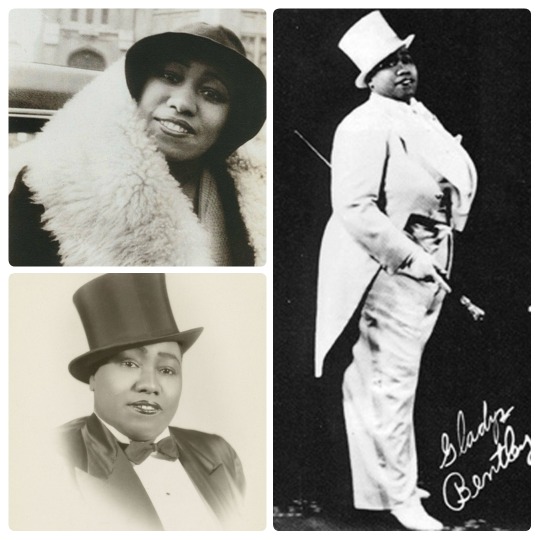
On August 12, 1907, blues pianist, singer, performer, and drag king pioneer Gladys Bentley was born in Philadelphia. She moved to New York City at the age of 16 and began her career as a performer at Harry Hansberry's Clam House on 133rd Street, one of the city's most notorious gay speakeasies.
In the early 1930s, she headlined at Harlem's Ubangi Club, where she was backed up by a chorus line of drag queens. She dressed in men's clothes (including a signature tuxedo and top hat), played piano, and sang her own raunchy lyrics to popular tunes of the day in a deep, growling voice while flirting with women in the audience.
Bentley was openly lesbian early in her career, but during the McCarthy Era in the 1950s, she started wearing dresses and married (within five months of meeting) Charles Roberts, age 28, a cook, in a civil ceremony in Santa Barbara, California, in 1952. Roberts later denied that they had ever married.
Bentley also studied to be a minister, claiming to have been "cured" by taking female hormones. In an effort to describe her supposed "cure" for homosexuality she wrote an essay, "I Am a Woman Again," for Ebony magazine in which she stated she had undergone an operation, which "helped change her life again.” She died of pneumonia in 1960 at age 52.
#gladys bentley#drag king#singer#performer#pianist#blues#very talented#read about her#black history#knowledge is power
14 notes
·
View notes
Photo
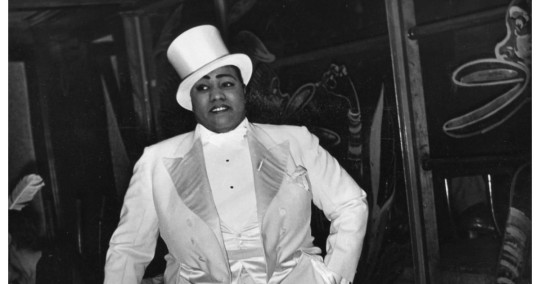
Gladys Bentley (deceased)
Gender: Female
Sexuality: Lesbian
DOB: 12 August 1907
RIP: 18 January 1960
Ethnicity: African American
Occupation: Singer, musician, entertainer, drag artist
Note 1: Her career skyrocketed when she appeared at Harry Hansberry's Clam House in New York in the 1920s, as a black, lesbian, cross-dressing performer. She headlined in the early 1930s at Harlem's Ubangi Club, where she was backed up by a chorus line of drag queens. She dressed in men's clothes, played piano, and sang her own raunchy lyrics to popular tunes of the day in a deep, growling voice while flirting with women in the audience.
Note 2: Due to what happened in the McCarthy Era she had to conform to society so she wouldn’t stand out as much (including dressing more feminine), claimed she wasn’t gay anymore and married twice but it didn’t last.
#Gladys Bentley#lgbt history#female#lesbian#1907#rip#historical#black#poc#african american#singer#musician#drag artist#plus size#popular#popular post#500
546 notes
·
View notes
Photo

Entertainer Gladys Bentley at the Ubangi Club in Harlem in the early 1930s.
2K notes
·
View notes
Text
Happy 4th day of pride! Today I’ll be sharing some past and present black lgbtq+ representatives!

1. Bessie Smith: Smith was an American blues singer widely renowned during the Jazz Age. Nicknamed the Empress of the Blues, she was the most popular female blues singer of the 1920s and 1930s. She is often regarded as one of the greatest singers of her era and was a major influence on fellow blues singers, as well as jazz vocalists. Smith became the highest-paid black entertainer of the day, heading her own shows, which sometimes featured as many as 40 troupers, and touring in her own custom-built railroad car. She was known for her sexual relationships with both female and male partners.

2. Gladys Bentley: Bentley was an American blues singer, pianist, and entertainer during the Harlem Renaissance. Her career skyrocketed when she appeared at Harry Hansberry's Clam House in New York in the 1920s, as a black, lesbian, cross-dressing performer. She headlined in the early 1930s at Harlem's Ubangi Club, where she was backed up by a chorus line of drag queens. She dressed in men's clothes (including a signature tuxedo and top hat), played piano, and sang her own raunchy lyrics to popular tunes of the day in a deep, growling voice while flirting with women in the audience.

3. Bayard Rustin: Rustin was an American leader in social movements for civil rights, socialism, nonviolence, and gay rights. Best known for being a key advisor to Reverend Martin Luther King Jr. Rustin organized the 1963 March on Washington and was posthumously awarded the Presidential Medal of Freedom. He was once arrested after being caught having sex with two men inside a car. (HONESTLY THERE IS SO MUCH MORE THIS AMAZING MAN DID! YOU REALLY NEED TO GO LOOK HIM UP.)
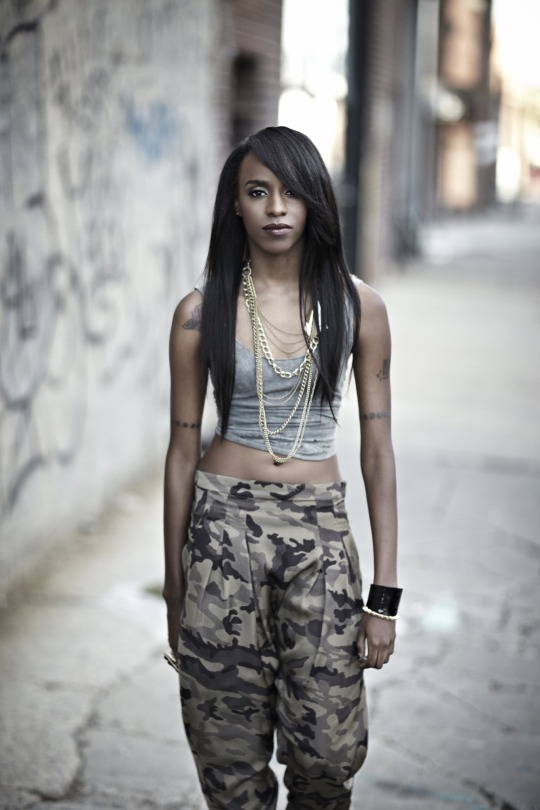
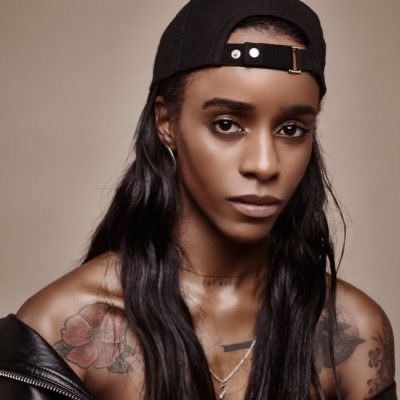
4. Raykeea Raeen-Roes Wilson “Angel Haze”: Haze is an American rapper and singer. Haze is is pansexual and agender and has said: "People talking about me, like, ‘I'm glad there's an actual woman of color representing queerness and pansexuality, someone who is like me in the spotlight.’"
#black pride#blacklivesalwaysmatter#blacklivesmatter#stop police violence#pride month#gay pride#lesbian pride#lgbt representation#lgbt pride#black lgbt#blm movement
21 notes
·
View notes
Text
Profiles of Pride: June 24th! 🏳️🌈Gladys Bentley🏳️🌈
Gladys Alberta Bentley (August 12, 1907 – January 18, 1960) was an American blues singer, pianist, and entertainer during the Harlem Renaissance.
Her career skyrocketed when she appeared at Harry Hansberry's Clam House in New York in the 1920s, as a black, lesbian, cross-dressing performer. She headlined in the early 1930s at Harlem's Ubangi Club, where she was backed up by a chorus line of drag queens. She dressed in men's clothes (including a signature tuxedo and top hat), played piano, and sang her own raunchy lyrics to popular tunes of the day in a deep, growling voice while flirting with women in the audience.
On the decline of the Harlem speakeasies with the repeal of Prohibition, she relocated to southern California, where she was billed as "America's Greatest Sepia Piano Player" and the "Brown Bomber of Sophisticated Songs". She was frequently harassed for wearing men's clothing. She tried to continue her musical career but did not achieve as much success as she had had in the past. Bentley was openly lesbian early in her career, but during the McCarthy Era she started wearing dresses and married, claiming to have been "cured" by taking female hormones.
Aside from her musical talent and success, Bentley is a significant and inspiring figure for the LGBT community and African Americans, and she was a prominent figure during the Harlem Renaissance. She was revolutionary in her masculinity: "Differing from the traditional male impersonator, or drag king, in the popular theater, Gladys Bentley did not try to 'pass' as a man, nor did she playfully try to deceive her audience into believing she was biologically male. Instead, she exerted a 'black female masculinity' that troubled the distinctions between black and white and masculine and feminine".
Fictional characters based on Bentley appeared in Carl Van Vechten's novel Parties, Clement Woods' novel Deep River, and Blair Niles' novel Strange Brother.
In 2019, The New York Times newspaper began a series called "Overlooked No More," in which the editorial staff aims to correct a longstanding bias in reporting by republishing obituaries for historical minorities and women. Bentley was one of the featured obituaries in Overlooked No More.

#Gladys Bentley#Profiles in Pride!#LGBTQIA+#LGBTQIA+ Rights#LGBTQIA+ Pride#Pride#Pride Month#June#June 24th
4 notes
·
View notes
Photo
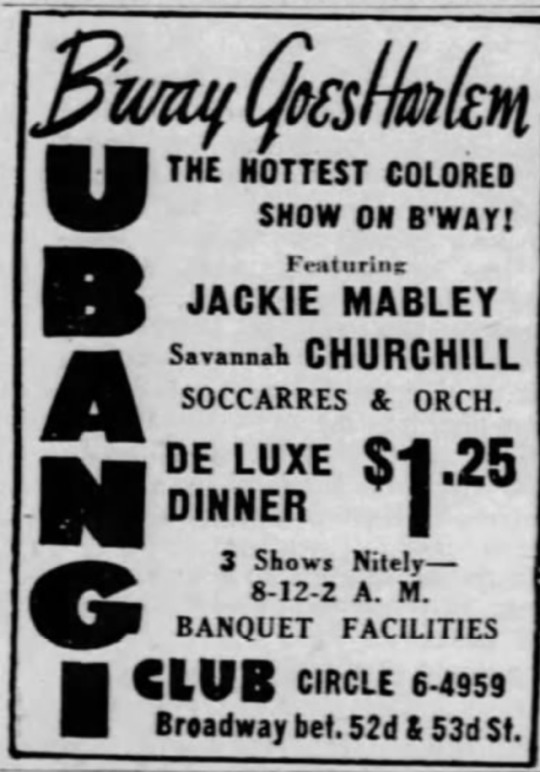
The short-llivid Ubangi Club was a failed attempt to bring the Chitlin Circuit to the heart of Manhattan.
4 notes
·
View notes
Photo

Gladys Alberta Bentley (August 12, 1907 – January 18, 1960) was a blues singer, pianist, and entertainer during the Harlem Renaissance. Her career skyrocketed when she appeared at Harry Hansberry's Clam House in New York, as a black, lesbian, cross-dressing performer. She headlined at Harlem's Ubangi Club, where she was backed up by a chorus line of drag queens. She dressed in men's clothes, played piano, and sang her raunchy lyrics to popular tunes of the day in a deep, growling voice while flirting with women in the audience. On the decline of the Harlem speakeasies with the repeal of Prohibition, she relocated to Southern California, where she was billed as "America's Greatest Sepia Piano Player" and the "Brown Bomber of Sophisticated Songs". She was harassed for wearing men's clothing. She tried to continue her musical career but did not achieve as much success as she had had in the past. She was openly lesbian early in her career, but during the McCarthy Era, she started wearing dresses and married, claiming to have been "cured" by taking female hormones. #africanhistory365 #africanexcellence https://www.instagram.com/p/CSenkd0ni-KeHqoNL9mmDq36jfK3GbRP1YkEuQ0/?utm_medium=tumblr
0 notes
Photo

Good morning my loves💛💛 what are you up to today?? . I'm gonna eat pretzels and work....I think. But who knows what the universe has in store for me. Who knows?? . Gladys Bentley (1907-1960) Bentley was a gender-bending performer during the Harlem Renaissance. Donning a top hat and tuxedo, Bentley would sing the blues in Harlem establishments like the Clam House and the Ubangi Club. According to a belated obituary published in 2019, The New York Times said Bentley, who died in 1960 at the age of 52, was "Harlem's most famous lesbian" in the 1930s and "among the best-known black entertainers in the United States." . __________________________________ #GeekInvie #cosplayer #blerd #OrangeCounty #lgbtqia+🌈 #BiPride #KenessaKeepingitCute #Disney #otaku #PRIDE2021 #geek #IAmMagicIAmReal #anime #comics #ootd #LosAngeles #DisneyHeaux . Snap Me👻: k.le5ah Tweet Me🐤: @geekinvie TikTok 🎶: @geekinvie Photo by 📸: @Krystal87 https://www.instagram.com/p/CQwArKGjbla/?utm_medium=tumblr
#geekinvie#cosplayer#blerd#orangecounty#lgbtqia#bipride#kenessakeepingitcute#disney#otaku#pride2021#geek#iammagiciamreal#anime#comics#ootd#losangeles#disneyheaux
0 notes
Photo

Gladys Bentley (1907-1960) was a gender-bending performer during the Harlem Renaissance. Donning a top hat and tuxedo, Bentley would sing the blues in Harlem establishments like the Clam House and the Ubangi Club. According to a belated obituary published in 2019, The New York Times said Bentley, who died in 1960 at the age of 52, was "Harlem's most famous lesbian" in the 1930s and "among the best-known black entertainers in the United States."
0 notes